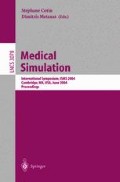Abstract
A key concern in the design of a simulator is the level of realism necessary for proper training, and the underlying question about the level of fidelity required. A new experimental method for surgeon sensory interaction characterization has been defined and implemented. It aims to determine the relative importance of three components of surgical skill training: surgical experience and knowledge, visual cues and tactile information. The implementation is centered in studying tissue consistency perception. Preliminary results are allowing to better understanding the visual haptics concept and the relevance of the use of force feedback for developing an effective simulator for laparoscopic training.
Access this chapter
Tax calculation will be finalised at checkout
Purchases are for personal use only
Preview
Unable to display preview. Download preview PDF.
References
Usón, J., Pascual, S., Sánchez, F.M., Hernández, F.J.: Pautas para el aprendizaje en suturas laparoscópicas. In: Usón, J., Pascual, S. (eds.) Aprendizaje en suturas laparoscópicas, Librería General S.A., Zaragoza, ch. 2, pp. 38–54 (1999)
Gallagher, A.G., Smith, C.D., Bowers, S.P., Seymour, N.E., Pearson, A., McNatt, S., Hananel, D., Satava, R.M.: Psychomotor skills assessment in practicing surgeons experienced in performing advanced laparoscopic procedures. Journal of the American College of Surgeons 197(3), 479–488 (2003)
Liu, A., Tendick, F., Cleary, K., Kaufmann, C.: A survey of surgical simulation: applications, technology, and education. Presence 12(6) (2003)
Kim, H.K., Ratter, D.W., Srinivasan, M.A.: The Role of Simulation Fidelity in Laparoscopic Surgical Training. In: Ellis, R.E., Peters, T.M. (eds.) MICCAI 2003. LNCS, vol. 2878, pp. 1–8. Springer, Heidelberg (2003)
Picinbono, G., Delingette, H., Ayache, N.: Non-linear anisotropic elasticity for real-time surgery simulation. Graphical Models 65(5), 305–321 (2003)
Dhruv, N., Tendick, F.: Frequency dependence of compliance contrast detection. In: Proc. ASME Dynamic Systems and Control Division, DSC, vol. 69, pp. 1087–1093 (2000)
den Boer, K.T., Herder, J.L., Sjoerdsma, W., Meijer, D.W., Gouma, D.J., Stassen, H.G.: Sensitivity of laparoscopic dissectors. What can you feel? Surg. Endosc. 13(9), 869–873 (1999)
Zhang, J., Payandeh, S., Dill, J.: Levels of detail in reducing cost of haptic rendering: a preliminary user study. In: Proc. 11th Symposium on Haptic Interfaces for Virtual Environment and Teleoperator Systems (HAPTICS 2003), pp. 205–212, (2003)
Seehusen, A., Brett, P., Harrison, A.: Human perception of haptic information in minimal access surgery tools for use in simulation. Stud. Health Technol. Inform. 81, 453–458 (2001)
Bholat, O.S., Haluck, R.S., Murray, W.B., Gorman, P.J., Krummel, T.M.: Tactile feedback is present during minimally invasive surgery. Journal of the American. College. of Surgeons. 189(4), 349–355 (1999)
Tendick, F., Downes, M., Goktekin, T., Cavusoglu, M.C., Feygin, D., Wu, X., Eyal, R., Hegarty, M., Way, L.W.: A Virtual Environment Testbed for Training Laparoscopic Surgical Skills. Presence 9(3), 236–255 (2000)
Wagner, C.R., Stylopoulos, N., Howe, R.D.: The role of force feedback in surgery: analysis of blunt dissection. In: Proc. 10th Symposium on Haptic Interfaces for Virtual Environment and Teleoperator Systems (HAPTICS), Orlando, pp. 68–74 (2002)
Delingette, H.: Toward realistic soft-tissue modeling in medical simulation. Proceedings of the IEEE 86(3), 512–523 (1998)
Dubois, P., Thommen, Q., Jambon, A.C.: In vivo measurement of surgical gestures. IEEE Trans. Biomed. Eng. 49(1), 49–54 (2002)
Stylopoulos, N., Cotin, S., Dawson, S., Ottensmeyer, M., Neumann, P., Bardsley, R., Russell, M., Jackson, P., Rattner, D.: CELTS: A clinically-based Computer Enhanced Laparoscopic Training System. Stud. Health Technol. Inform. 94, 336–342 (2003)
Author information
Authors and Affiliations
Editor information
Editors and Affiliations
Rights and permissions
Copyright information
© 2004 Springer-Verlag Berlin Heidelberg
About this paper
Cite this paper
Lamata, P. et al. (2004). A New Methodology to Characterize Sensory Interaction for Use in Laparoscopic Surgery Simulation. In: Cotin, S., Metaxas, D. (eds) Medical Simulation. ISMS 2004. Lecture Notes in Computer Science, vol 3078. Springer, Berlin, Heidelberg. https://doi.org/10.1007/978-3-540-25968-8_20
Download citation
DOI: https://doi.org/10.1007/978-3-540-25968-8_20
Publisher Name: Springer, Berlin, Heidelberg
Print ISBN: 978-3-540-22186-9
Online ISBN: 978-3-540-25968-8
eBook Packages: Springer Book Archive

